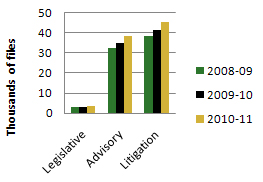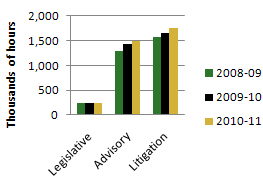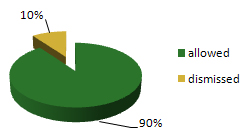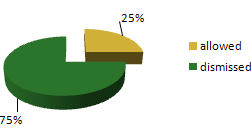Common menu bar links
Breadcrumb Trail
ARCHIVED - Department of Justice Canada - Report
 This page has been archived.
This page has been archived.
Archived Content
Information identified as archived on the Web is for reference, research or recordkeeping purposes. It has not been altered or updated after the date of archiving. Web pages that are archived on the Web are not subject to the Government of Canada Web Standards. As per the Communications Policy of the Government of Canada, you can request alternate formats on the "Contact Us" page.
Section II: Analysis of Program Activities by Strategic Outcome
Strategic Outcome I - A fair, relevant and accessible justice system that reflects Canadian values
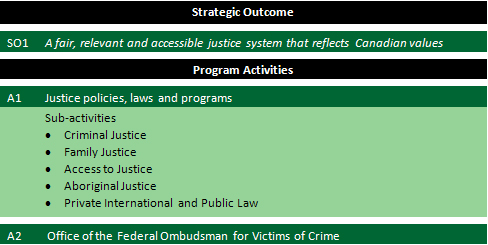
Ensuring that the justice system is fair, relevant and accessible and that it reflects Canadian values is a responsibility that does not lie with the Department of Justice alone; rather, it involves a broad range of players, including Parliament, the judiciary, federal departments and agencies, partners in provincial, territorial and municipal governments, a broad range of non-governmental organizations and stakeholders, and, ultimately, all Canadians.
The Department plays a major part in this by carrying out its fundamental role in establishing, maintaining and refining the national legal framework. It also exercises a leadership role in consulting and collaborating with federal, provincial, territorial, municipal and non-governmental partners to identify and address issues that affect the fairness, accessibility and relevance of the Canadian justice system.
This Strategic Outcome is supported by two program activities: Justice policies, laws and programs and the Office of the Federal Ombudsman for Victims of Crime.
Program Activity A1: Justice policies, laws and programs
Under Canada's federal system, the administration of justice is an area of shared jurisdiction between the federal government and the provinces. Through this program activity, the Department fulfils its responsibility to ensure a bilingual and bijural national legal framework for the administration of justice by developing policies and laws and testing innovative approaches to strengthen the framework within the following domains: criminal law, youth criminal justice, sentencing, marriage and divorce, access to justice and Aboriginal justice. Through this program activity, the Department also provides significant ongoing funding to provinces and territories in support of their responsibility for the day-to-day administration of justice.
| Planned Spending | Total Authorities | Actual Spending22 |
|---|---|---|
| 429.8 | 443.1 | 428.1 |
| Planned | Actual | Difference |
|---|---|---|
| 361 | 366 | 5 |
| Expected Results |
Performance Indicators |
Targets23 | Performance Status24 |
|---|---|---|---|
| A sustainable national justice system | Trends in per capita spending by all levels of government in Canada on the justice system | Not available | Total criminal justice spending for 2009 was $14.9 billion or $442 in per capita costs.25 Compared to 2008, when total criminal justice spending was $14.2 billion or $426 per capita, criminal justice spending increased by approximately 5%.26 |
| Trends in lag time from charges to court resolution | Average time from charges to court resolution: 220 days in 2009-10 (nine days shorter than previous year).27 | ||
| Trends in crime indexes | Police-reported Crime Rate declined by 5% in 2010 compared to the previous year28; Severity of crime (according to the Crime Severity Index) declined by 6% in 201029 compared to the previous year.30 | ||
| Criminal law is reformed to respond to emerging issues | Trends in justice process | Not available | Average length of case from first to last appearance: 220 days in 2009-2010 (nine days shorter than in previous year).31 |
| Trends in outcome fairness |
In 2009-10, the average (mean) custodial sentence for crimes:
The average custodial sentence for all other Criminal Code offences, excluding traffic offences was 114 days. 32, 33 |
||
| Trends in the ratio of chargeable incidents to charges laid for criminal offences | In 2010, charges were laid in 27.5% of the chargeable incidents, including traffic offences (down 0.1 % from previous year).34 | ||
| Canadians have a positive perception of the criminal justice system | Trends in self-reported victimization | Not available | In 2009, 27% of Canadians aged 15 years and older reported being the victim of crime; 30% of which was violent in nature, while 70% was non-violent. These most recent results are similar to results from 2004.35 |
| Trends in public perceptions of personal safety | In 2009, 47.6% of Canadians reported to be very satisfied with their personal safety and 45.1% reported to be somewhat satisfied.36 These results are similar to the General Social Survey findings from 2004. | ||
| Trends in public perceptions of the justice system | In 2011, 50.5% of Canadians attested confidence in the adult criminal justice system and 39.7% reported confidence in the youth criminal justice system. Results remained relatively stable compared to 2009.37 | ||
| Increased compliance by parents with the terms and conditions of family support, custody and access obligations | Trends in compliance/non-compliance with family law obligations | Not available |
In 2010-11, there were, 21,255 applications to locate debtors in default of child support obligations38 (11% fewer than in 2009-10). In 2010-11, there were 9,625 licence denials against persistent defaulters (12% fewer than 2009-10.)39 |
| Equitable access to the justice system | Public perceptions regarding access to justice | Not available | 20% of Canadians strongly agree, and 53% somewhat agree, that the laws and justice system are fair.40 |
| Number of stays in proceedings due to lack of counsel | There was no stay in Public Safety and Anti-terrorism proceedings or in federal prosecution cases where there was a court-ordered counsel.41 | ||
| Number of instances of court-ordered counsel | The Department entered into 45 funding agreements for the provision of counsel with provinces, territories or their legal aid delivery entities, when mandated by the court to avoid a stay in proceedings.42 | ||
| Increased involvement of Aboriginal communities in the local administration of justice | Number of communities with Aboriginal Justice Strategy projects | Not available | 144 Aboriginal Justice Strategy community-based justice programs (up two from the previous year) serving approximately 400 communities.43 |
| Number of communities undertaking capacity building and training to support the administration of justice | 48 capacity building and training projects in Aboriginal communities (up one from the previous year).44 | ||
| Number of clients served by Aboriginal justice programs (year-over-year data) |
Approximately 52,000 Aboriginal people, of whom 27% were women, received services from the Aboriginal Courtwork Program. 21 organizations funded to deliver programs under the Missing and Murdered Aboriginal Women Initiative. |
Performance Summary and Analysis of Program Activity
All departmental efforts under Program Activity A1, “Justice policies, laws and programs,” support the Department’s Strategic Objective 1, “A fair, relevant and accessible justice system that reflects Canadian values.” In 2010-11, the Department continued to work to achieve the expected results that were set out for this program activity in the Report on Plans and Priorities.
A sustainable national justice system
In support of a sustainable national justice system, the Department of Justice continued to support the Government in reviewing its approach to addressing youth justice issues through legislative amendments, programming and events encouraging open dialogue with partners. The Department continued to manage the Youth Justice Services Funding Program45, and completed its renewal strategy in collaboration with provincial and territorial officials.
The Department has also been instrumental in supporting the Government’s efforts to stand up for the rights of victims and law-abiding Canadians. A number of outreach activities were organized to enhance support services for victims of crime and a national Knowledge Exchange on Child Advocacy Centres was co-hosted by the Department, whereby representatives from police services, victim services, mental health and medical services, child advocacy, policy development, and academia participated.
Furthermore, a summative evaluation of the Federal Victims Strategy was completed in 2010-11.46 It concluded that there is an ongoing need for the Strategy and that the Policy Centre for Victim Issues is fulfilling its mandate and achieves good results at low cost.
Criminal law is reformed to respond to emerging issues
In collaboration with provinces and territories, the Government sought to modernize and streamline the criminal justice process by maximizing the use of technology, simplifying procedures, and rationalizing police presence in court (e.g. introduction of Bill C-50, Improving Access to Investigative Tools for Serious Crimes Act; Bill C-53, Fair and Efficient Criminal Trials Act; and active participation in the development of a number of reports on the need to update the wiretapping provisions in the Criminal Code). The Department also developed law reform proposals on security and anti-terrorism (e.g. Bill C-17, Combating Terrorism Act).
The Department worked with international partners to ensure that international legal frameworks – including the United Nations Convention against Transnational Organized Crime, and the protocols dealing with migrant smuggling and trafficking of persons, as well as those of the United Nations Commission on Crime Prevention and Criminal Justice – adequately combat organized crime and terror. The Department also worked to enhance cross-border law enforcement cooperation and developed proposals for extradition reform.
Canadians have a positive perception of the criminal justice system
One way the Department measures success in delivering a fair justice system is by assessing the confidence Canadians report in the criminal justice system. In 2011, Canadians continued to report having a positive perception of the justice system. Twenty percent of Canadians strongly agreed, and 53% somewhat agreed, that the Canadian justice system is fair. With respect to the criminal justice system, 50.5% of Canadians reported having confidence in the adult criminal justice system, while 39.7% of Canadians reported having confidence in the youth criminal justice system.47 These numbers have remained relatively stable over the past few years.
Increased compliance by parents with the terms and conditions of family support, custody and access obligations
The Department continued its efforts to increase compliance of family support obligations. This year, more than $163 million was garnisheed for the benefit of Canadian families entitled to support payments, in response to 131,545 garnishee summonses.48 Amendments are being proposed to the Family Support Orders and Agreements Garnishment Regulations to add the Apprenticeship Completion Grant and the Wage Earner Protection Program to the list of federal funds that may be garnisheed in satisfaction of family support and to allow provincial enforcement services to serve a garnishee summons by electronic communication. These were published in the Canada Gazette, Part I on February 19, 2011.
The Department worked closely with its provincial and territorial partners to promote family justice. In addition to law reform, the Department enhanced family justice services and programs and contributed to the development of family justice information resources, particularly those that promote compliance with family law obligations. This was achieved through new funding agreements with provincial and territorial governments and with non-government organizations.
The Department continued to implement the Survey of Maintenance Enforcement Programs and the Civil Court Survey to gather information relating to maintenance enforcement. Research conducted includes the collection of family justice data from the provinces and territories to determine levels of different outcomes for children upon separation and divorce. Additionally, a new initiative through a Memorandum of Understanding with Passport Canada will mean more effective passport suspensions or denials under the Family Orders and Agreements Enforcement Assistance Act.
Equitable access to the justice system
The Department seeks to improve access to justice in civil, family and criminal matters, recognizing that barriers to accessing justice, including high legal fees, the lack of reliable information, and overburdened courts, need to be addressed. While the vast majority of people take some action to resolve legal problems, very few resort to the formal justice system. This reaffirms the importance of providing high-quality information about the law and the justice system. In 2010-11, the Department provided access to justice through public legal education as well as funding through various programs to increase public knowledge about the legal system (e.g. Justice Partnership and Innovation Program, the Family Violence Initiative, the Aboriginal Courtwork Program, the Victims Fund). Under the Missing and Murdered Aboriginal Women Initiative, the Department also provided funding to 15 Aboriginal organizations to develop awareness material on breaking cycles of violence and abuse.49
As all levels of government are responsible for ensuring that the Canadian justice system is accessible, the Department also worked with provinces, territories and stakeholders. To ensure the right to a fair trial for individuals charged with a serious criminal offence that involves complex legal issues and where there is a likelihood of incarceration upon conviction, funding agreements are in place to provide counsel, when mandated by the courts, thereby avoiding stays in proceedings. The Federal-Provincial-Territorial Permanent Working Group on Legal Aid continued to facilitate information sharing and collaboration between the federal government and other jurisdictions, and funding agreements for criminal legal aid have been extended with all provinces until March 31, 2012. The Department has also implemented, with its partners, the training component of the Access to Justice in Both Official Languages Support Fund. This fund supported 27 projects to provide advanced training on legal terminology for bilingual justice professionals, curriculum development and recruitment strategies, and the development of linguistic training tools.
Increased involvement of Aboriginal communities in the local administration of justice
The Department continued to work collaboratively with provincial and territorial partners through regular meetings of the Aboriginal Justice Strategy Federal-Provincial-Territorial Working Group. These meetings enabled Aboriginal communities to have increased involvement in the local administration of justice; to provide timely and effective alternatives to mainstream justice processes in appropriate circumstances; and to decrease the rates of victimization, crime and incarceration among Aboriginal people through its program funding and information sharing. The Aboriginal Justice Strategy called for the delivery of five dialogue sessions across Canada with provincial and territorial colleagues, funding recipients, and stakeholders to inform the Aboriginal Justice Strategy renewal process, which is guided by an overall renewal strategy.
Lessons Learned
The Department had planned to implement international technical legal assistance projects to promote freedom, democracy, human rights and the rule of law in Ukraine, Jamaica and the West Bank. Implementation of the projects went ahead in Ukraine and the West Bank. However, the project to support the modernization of the justice system in Jamaica did not begin as planned. The project is being redesigned and is expected to start in 2011-12. Lessons learned in the Jamaica project will be integrated in the elaboration of future initiatives.
The Department has also taken steps to ensure that it is better positioned to deliver justice programs and policies in a complex operating environment. In 2010-11, steps were taken towards strengthening collaboration with the Department’s partners in the justice system. Efforts included the convening of regional Aboriginal youth gang intervention forums with police, criminal justice personnel and community stakeholders, as well as organizing and participating in workshops focused on mental health needs of youth, substance abuse and the National Anti-Drug Strategy to inform its policies and programs and support knowledge sharing with stakeholders.
Additionally, during the reporting period the Department followed up on a symposium held in 2009 on family violence with the creation of the Ad Hoc Federal-Provincial-Territorial Working Group on Family Violence. Its purpose is to further explore challenges posed by the different objectives and legal standards of the criminal and family justice system responses to family violence. Moving forward, these efforts to further knowledge sharing and strengthen collaboration will support the Department as it strategically aligns its resources with programs and initiatives that strengthen the overall system of justice and supports the Government’s efforts to tackle crime and stand up for the rights of victims and law-abiding Canadians.
Program Activity A2: Office of the Federal Ombudsman for Victims of Crime
This program activity raises awareness of the needs and concerns of victims in areas of federal responsibility, provides an independent resource that addresses complaints of victims about compliance with the provisions of the Corrections and Conditional Release Act that apply to victims of offenders under federal supervision, and helps victims to access existing federal programs and services.
| Planned Spending | Total Authorities | Actual Spending50 |
|---|---|---|
| 1.3 | 1.4 | 1.3 |
| Planned | Actual | Difference |
|---|---|---|
| 9 | 11 | 2 |
The Office of the Federal Ombudsman for Victims of Crime was established in 2007 as an arm’s-length program activity of the Department of Justice. The Ombudsman reports directly to the Minister of Justice and, as such, the Office falls outside the Department’s governance framework. The Office receives corporate services support from the Department.
The mandate of the Federal Ombudsman for Victims of Crime, which relates exclusively to matters of federal responsibility, is:- to promote access by victims to existing federal programs and services for victims;
- to address complaints of victims about compliance with the provisions of the Corrections and Conditional Release Act that apply to victims of crimes committed by offenders under federal jurisdiction;
- to promote awareness of the needs and concerns of victims and the applicable laws that benefit victims of crime, including promoting the principles set out in the Canadian Statement of Basic Principles of Justice for Victims of Crime with respect to matters of federal jurisdiction, among criminal justice personnel and policy makers;
- to identify and review emerging and systemic issues, including those related to programs and services provided or administered by the Department of Justice or the Department of Public Safety, that negatively impact victims of crime; and
- to facilitate access by victims to existing federal programs and services by providing them with information and referrals.
For further information regarding the activities of the Office of the Federal Ombudsman for Victims of Crime, please visit the Office’s Web site at http://www.victimsfirst.gc.ca/.
Strategic Outcome II: A federal government supported by effective and responsive legal services
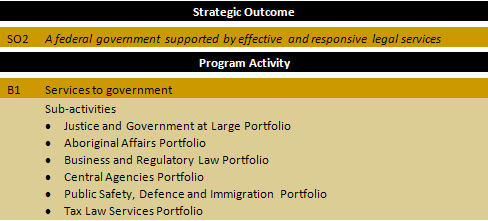
Under the Department of Justice Act, the Minister of Justice and Attorney General of Canada provides legal services to the federal government and its departments and agencies. According to section 4 of the Act, the Minister is the legal member of the Queen’s Privy Council responsible for seeing that the administration of public affairs is in accordance with the law. Additionally, under section 4.1, the Minister is responsible for drafting and reviewing all government regulations prior to registration to ensure conformity with the Statutory Instruments Act and all government bills prior to tabling in Parliament to ensure that the bills are not inconsistent with the Canadian Charter of Rights and Freedoms. Under section 5 of the Act, the Attorney General is responsible for advising the heads of government departments on all matters of law and for conducting all litigation for any federal department or agency of the Crown with respect to any subject within the authority or jurisdiction of Canada.
The Department seeks to attain this strategic outcome through one program activity: Services to Government.
Program Activity B1: Services to Government
As a common service provider, the Department of Justice provides an integrated suite of legal advisory, litigation and legislative services to departments and agencies to help them meet their policy and programming priorities and advance the overall objectives of the Government. Through this program activity, the Department also provides legal services to the Justice Portfolio and supports the Minister as legal advisor to the Cabinet on complex, whole-of-government issues.
| Planned Spending51 | Total Authorities | Actual Spending52 |
|---|---|---|
| 183.4 | 494.4 | 455.5 |
| Planned | Actual | Difference |
|---|---|---|
| 3,293 | 3,403 | 110 |
| Expected Results |
Performance Indicators |
Targets53 | Performance Status54 |
|---|---|---|---|
| Comprehensive delivery on the Government's legislative agenda | Levels of effort dedicated to legislative files | Not available | 249,339 hours were dedicated to 3,717 files. |
| Number of bills tabled in Parliament | 59 bills were introduced. | ||
| Number of regulations published in the Canada Gazette |
|
||
| Number of motions to amend private members’ bills for which the Department was responsible | 60 motions for amendment were drafted for private members’ bills. | ||
| Legal advisory services to support the Government in attaining its priorities | Levels of effort devoted to providing legal advisory services to client organizations | Not available | 1,491,142 hours were dedicated to 38,228 files. |
| Representing the Crown’s interest to enable the Government to attain its priorities | Levels of effort dedicated to litigation files | Not available | 1,745,688 hours were dedicated to 45,415 files. |
| Trends in levels of assessed risk of the litigation inventory | Of all the litigation files with a risk assessment, 57% were low-risk files, 41% medium-risk and 2% were high-risk55 | ||
| Trends in the settlement of disputes through alternatives to litigation | The percentage of files settled through alternatives to litigation has remained constant over the last three years, averaging 26% per year. | ||
| Trends in Crown results for litigation files – final litigation outcome indicators | Of all proceedings initiated by the Crown (in court or tribunal), 90% were allowed; of those initiated against the Crown, 75% were dismissed. |
Performance Summary and Analysis of Program Activity
During the reporting period, the Department continued to build on its integrated suite of legislative, legal advisory and litigation services to support the Government in delivering its legislative agenda and attaining its priorities, and to represent the Crown’s interest in court and tribunal proceedings.
The performance summary and analysis of program activity describes in further detail how the Department performed against its expected results and summarizes some of its key achievements towards fulfilling the commitments set out in the planning highlights of the Report on Plans and Priorities.
Comprehensive delivery on the Government's legislative agenda
The number of bills tabled this year remained stable compared to the previous year – up 1 from the previous year (58 in 2009-10 and 59 in 2010-11). While the number of bills tabled has been somewhat constant in the past two fiscal years, the number of regulations published in the Canada Gazette has increased significantly in 2010-11. The number of regulations published in Part I of the Canada Gazette increased from 73 in 2009-10 to 172 in 2010-11, while the number of regulations published in Part II increased from 16856 in 2009-10 to 318 in 2010-11. These efforts contributed to legally sound and effective bills and regulations being drafted on a timely basis to meet Government priorities.
Trends in the number of bills tabled in the House of Commons
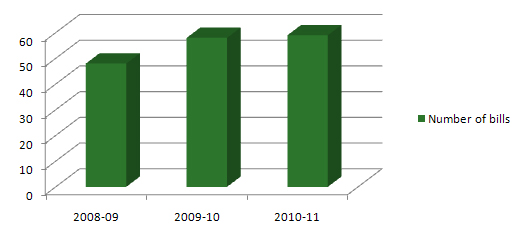
Trends in the number of regulations published in the Canada Gazette
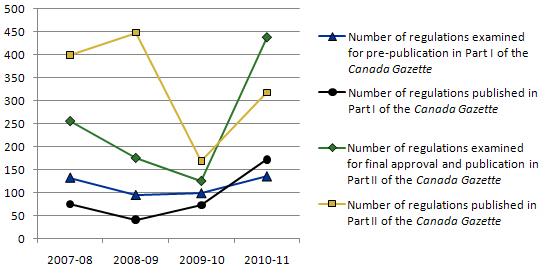
Legal advisory services to support the Government in attaining its priorities
In 2010-11, a total of 1,491,142 hours were dedicated to 38,228 advisory files to support the Government in attaining its priorities. This represents an increase of approximately 3% from the previous year and can be attributed to an increased demand from clients. The advice provided enabled federal departments and agencies to be fully informed of legal issues and risks which promoted sound decisions.
In order to promote continual improvement of the legal services that the Department provides to its clients in supporting the achievements of their priorities, the Department of Justice Canada Client Feedback Survey was developed to measure the satisfaction of client organizations. The survey is conducted on a three-year cycle basis, and preliminary results on the overall quality of legal advisory, litigation and legislative and regulatory drafting services were very positive. Overall ratings exceeded departmental targets for all four types of services, demonstrating the Department’s success in delivering client-focused legal services. The complete departmental roll-up of results will be available in 2012.
| Legal advisory services | Litigation services | Legislative drafting services | Regulatory drafting services |
|---|---|---|---|
| 8.4/10 | 8.2/10 | 8.6/10 | 8.8/10 |
Representing the Crown’s interest to enable the Government to attain its priorities
During the reporting period, client demand for litigation services continued to grow. In the past year, the level of effort required to provide litigation services to client departments increased by 5%.
|
Trends in the number of files
|
Trends in levels of effort
|
In 2010-11, 90% of all adjudicated proceedings initiated by the Crown were allowed (up from 88% during the previous reporting period), 75% of those initiated against the Crown were dismissed (up from 70% during the previous reporting period).
|
Proceedings initiated by
|
Proceedings initiated against
|
As presented in the following graph, while only accounting for 2% of litigation files, high-risk litigation accounts for 28% of the level of effort devoted to litigation across the Department. In contrast, low-risk files required approximately the same level of effort (27%), yet they make up almost 60% of the file inventory.57
Percentage of files and level of effort by risk level
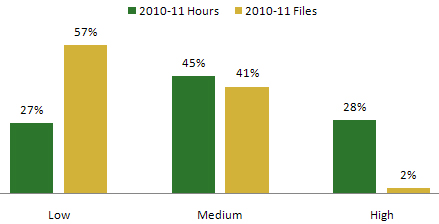
The Department closely monitors the risk profile of litigation files in order to allocate resources effectively. By continuing to work with client departments to identify and manage legal risks, the Department ensures high quality and timely legal advice and services.
Performance against planning highlights
The Department’s activities in connection with the delivery of legal services are aligned with the Government Affairs spending area outlined in Canada’s Performance Report. The Department of Justice supported other departments and agencies throughout the year in achieving their strategic outcomes and in delivering the Government’s policy and legislative agenda. Specifically, the Department continued to contribute to “well-managed and efficient government operations.” Below is a summary of the Department’s performance against the planning highlights that were set out in the Report on Plans and Priorities with regard to the delivery of legal services.
Economic Affairs
As noted in the Report on Plans and Priorities, the Department of Justice had a key role in supporting government departments and agencies in continuing the implementation of Canada’s Economic Action Plan. Legal Services participated in the drafting of bills that implemented Government policy as set out in Budget 2010. Ongoing legal support was also provided to Transport Canada and Infrastructure Canada in implementing the Economic Action Plan investments, including roads, bridges, community centres and green infrastructure projects. These efforts helped to create jobs, stimulate the economy, and support Canadian families.
Moreover, in support of the development of a Canadian securities regulatory regime, the Department provided legal advice to Finance Canada and drafted the Canadian Securities Act. Ongoing litigation services were also provided to address challenges to the proposed regime in the references heard by the Quebec and Alberta Courts of Appeal, as well as in the Government of Canada’s reference to the Supreme Court of Canada on Parliament’s authority to implement a federal securities regulatory regime.
The Department also completed a number of activities to support the enhancement of Aboriginal economic development and to remove impediments. For example, it provided legal services and advice to Aboriginal Affairs and Northern Development Canada58 in its work to address barriers in the Indian Act and in making progress on Bill S-4, Family Homes on Reserves and Matrimonial Interests or Rights Act.
Social Affairs
The Department provided advice to support a number of initiatives and activities related to public safety, defence and immigration matters. These include the development of legislative amendments to reform Canada’s parole system,59 the modernization of the Royal Canadian Mounted Police (RCMP) to respond to recommendations of the Brown Task Force on Governance and Cultural Change at the RCMP,60 and the development of legislative amendments to strengthen Canada’s response to migrant smuggling.61
Moreover, the Department continued to provide legal services to Aboriginal Affairs and Northern Development Canada in support of the Government’s Specific Claims Action Plan. The Department made significant progress in accelerating the resolution of specific claims by clearing 85% of the backlog of inventory of more than 500 claims waiting for lawful obligation opinions in the context of the Specific Claims Policy. In fiscal year 2010-11, counsel supported 147 ongoing active negotiations and assisted in the settlement of 18 claims with a total value of more than $665 million. Similarly, counsel provided support to make progress on Bill S-11, An Act Respecting the Safety of Drinking Water on First Nation Lands.
In support of a reference filed by the Attorney General of British Columbia in 2009, counsel for the Attorney General of Canada defended section 293 of the Criminal Code, the provision which prohibits polygamy. The work of the Department has contributed to evidence regarding the harms of polygamy and to the interpretation and scope of the polygamy provision.
The Department of Justice provided litigation services in response to the judicial inquiry into the decline of sockeye salmon in the Fraser River, and developed a framework agreement with Aboriginal Affairs and Northern Development Canada for a long-term, sustainable approach to the management and resourcing of legal advisory services.
International Affairs
In 2010-11, the Department supported Canada’s efforts at the G8 summit and again at the G20 summit. To this end, the Department provided advice to support the preparation for the summits and litigation services in relation to proceedings launched following those events. Advice was also provided to support the implementation of G8 and G20 recommendations by proposing legislative or regulatory avenues to strengthen global financial regulation and counter money laundering activities.
The Department worked to support efforts to suppress funding for terrorism, which included the provision of litigation and legal advisory services with respect to an application for judicial review seeking to declare the United Nations Al-Qaida and Taliban Regulations invalid. Litigation services were also provided in high-profile national security cases, including those involving security certificates.
In order to defend Canada’s interest in trade litigation and its negotiating position on economic harmonization in international organizations, Justice counsel monitored and gave advice on significant international trade or commercial arbitration cases. The Department advised Finance Canada on international trade negotiations.
Government Affairs
The Department defended the Government against 12 challenges to employment-related legislation, including the Public Service Labour Relations Act and the Expenditure Restraint Act, in which it is alleged that the right to freedom of association protected by section 2(d) of the Charter has been violated.
The Court upheld the position of the Crown Department defended the Government against claims respecting federal superannuation accounts. The Department also defended challenges to the Supplementary Death Benefit schemes set out in the Public Service Superannuation Act and the Canadian Forces Superannuation Act, which resulted in a dismissal of the action by the Supreme Court of Canada.
The Department defended the Crown before the Ontario Court of Appeal in relation to claims by public sector unions, employee and retiree associations to excess credited amounts in federal superannuation accounts. The Court decided in favour of the Crown. The Department prepared for appeal of the decision to the Supreme Court of Canada by the Plaintiff.
The Department also supported preparation of the Federal Budget and the Fall Economic Update and prepared Budget 2010 and Budget 2011 implementation bills.
Lessons Learned
While the Client Feedback Survey preliminary results show that the Department’s performance has exceeded the targets (8.0 on a 10-point scale) for the overall quality of each of its four types of legal services (legal advisory, litigation, legislative drafting and regulatory drafting services), there are some areas where there is room for improvement. The Department’s performance for five of the ten published service standards for the provision of legal services to government received a mean score higher than 8.0/10 (exceeding the departmental target). For three other standards it fell just shy of the target, with a mean score of 7.9/10. However, the results indicate that there is a need to focus efforts on providing clients with regular and informative feedback or progress reports on the status of legal files as well as further involving them in the development of positions.
It should be noted that these conclusions are based on interim results that only reflect the feedback from the nine client organizations surveyed in 2010-11. The final results of the Client Feedback Survey are expected to be available in 2012, after all client organizations have been surveyed. The performance measures for client satisfaction will also be reviewed when the final results are available.
Program Activity C1: Internal Services

Internal Services are groups of related activities and resources that are administered to support the needs of programs and other corporate obligations of an organization. These groups are: Management and Oversight Services; Communications Services; Legal Services; Human Resources Management Services; Financial Management Services; Information Management Services; Information Technology Services; Real Property Services; Materiel Services; Acquisition Services; and Travel and Other Administrative Services. Internal Services include only those activities and resources that apply across an organization and not to those provided specifically to a program.
| Planned Spending | Total Authorities | Actual Spending62,63 |
|---|---|---|
| 104.8 | 151.6 | 164.7 |
| Planned | Actual | Difference |
|---|---|---|
| 1,215 | 1,218 | 3 |
Performance Summary and Analysis of Program Activity
In 2010-11, the Department continued to build on the sound management of its internal services to support the delivery of its mandate, paying particular attention to four priority areas identified in the Report on Plans and Priorities: law practice management, renewal of departmental systems and infrastructure, financial management, and public service renewal.
Law Practice Management
In 2010-11, the Department improved the productivity of its counsel and paralegals by developing and increasing access to new tools to support the practice of law. Among other things, the Department updated the legal commentary guide for the Commercial Arbitration Act; updated its inventory of model dispute resolution clauses and guides; improved the functionality of its legal case management system; advanced work on renewing the legal risk management system; and launched a project to develop performance measurement tools for alternative dispute resolution. The Department also continued to integrate gender-based analysis into all aspects of its work.
Renewal of departmental systems and infrastructure
The knowledge economy, connectivity and remote access to technology have become essential to many aspects of the Department’s work. With more than a third of the Department’s employees being co-located within client department offices and the growing number of teleworkers and others working remotely, the Department has made significant upgrades to adapt its systems and improve remote connectivity. This includes the pilot of a new virtual desktop technology that will ensure that all employees have access to all systems. This should be fully implemented by the end of 2011.
The Department completed the upgrade of its network infrastructure to meet government-wide standards in order to leverage government investments and provide the ability to quickly and easily upgrade to higher capacities.
Furthermore, the Department leveraged the Government of Canada high-availability data centre to continue improving business continuity and add functionality to services such as remote access, e-mail, and network optimizations.
Financial management
The Department continues to make progress in its action plans to address the financial management recommendations from the Office of the Auditor General’s management letter, which stemmed from the unqualified audit opinion on the Department’s 2008-09 financial statements.
As part of these plans, a number of improvements to financial controls were established in 2010-11, such as ensuring compliance with sections 32, 33 and 34 of the Financial Administration Act and eliminating the use of manually prepared cheques, to be completed by March 31, 2012.
Other changes, primarily related to information technology systems controls over change management, user access, security administration and vendor creation, have continued to unfold as planned in conjunction with longer-term enhancements and upgrades of the financial system.
Public service renewal
In support of public service renewal, the Department continued to focus on the provision of legal training and development opportunities to enhance the legal skills and expertise of its legal professionals. This included, for example, the launch of a new mandatory National Legal Orientation Program for entry-level counsel. Several new courses were added to the legal education program. More than 114 legal courses (up from 90 in 2009-10) and nine conferences were delivered, attracting more than 4,000 participants in the National Capital Region and 600 in the regions through webcast or videoconference. The Department also launched the second cohort of the Justice Leaders of Tomorrow Program, which includes a new language training component of up to six months to better prepare employees to occupy positions of management and leadership.
Initiatives that were completed in support of the Department’s commitment to employment equity and diversity include the implementation of employment equity goals in the Performance Management Agreement, which resulted in the closing of gaps and increases in representation of designated groups. Other initiatives, such as the delivery of 24 diversity awareness sessions to 2,379 employees (almost 50% of the work force), whereby 85% of participants reported improvement in their understanding and awareness of employment equity and diversity, helped to enable the culture change required to further support the attainment of a diverse and equitable workplace.
Efficiencies in the delivery of human resources services to managers are continuing to evolve with the use of improved technology to streamline and simplify processes as well as providing automation and self-service capability. For example, the Fast-Track Human Resources services were expanded to reduce the processing time in staffing and classification actions.
Lessons Learned
Engagement, interaction and knowledge sharing are critical to the successful development and implementation of law practice management initiatives. Implementing complex change takes time, and many variables affect how fast results are achieved. Consequently, to provide additional time for employees to adapt to new practices and processes, timelines were extended for the development of a quality assurance framework for legal services, renewal of the overall framework for legal risk management, deployment of a legal knowledge management portal, and the development of a performance measurement framework for alternative dispute resolution. Moving forward, the Department will continue to carefully monitor progress made against established action plans and shift resources or re-evaluate timelines as appropriate.
In financial management, the project on payroll verification processes and procedures was put on hold following the Government’s announcement of its intention to centralize pay in Miramichi, New Brunswick. However, this project is now being restarted since the Department will not be scheduled for centralization of pay before 2015. The new estimate for completion of the project is 2012-13.
On the public service renewal front, while the Department strengthened the connection between planned staffing actions and the associated planned salary expenditures, the implementation of this new process presented challenges. The use of the new Salary Forecasting Tool is beneficial, as are the new processes for completing the staffing plans. However, the introduction of these new tools has been challenging. In response, more integrated outreach and training will be undertaken, and communications and tools for all components of the business plans will be further refined for the next planning cycle.

